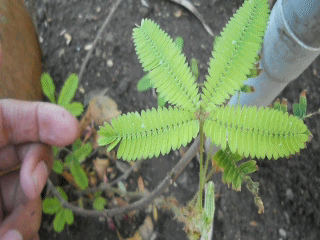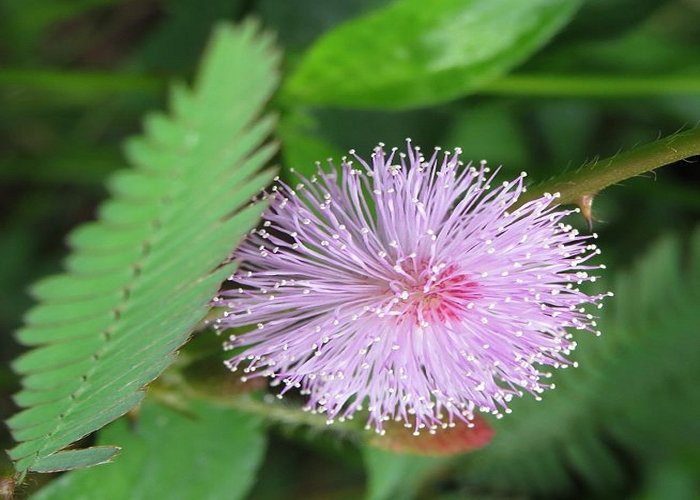Have you ever had the experience of touching a leaf of a leaflets-bearing plant and just in that instant the leaf recoiled and folded in? Or carrying out some agricultural activities in your farmland and while walking by some plants, you noticed that their leaves folded in on touching your body?
Those of us who were born in the cities and have remained in the cities since birth, may not have had this experience. But if you have ever lived in the country side where you have to walk on trails and bush paths to get from one village to another, the chances are you have had this experience. The name of the plant that displays this amazing uniqueness is Mimosa pudica.

[Mimosa pudica. Source: Wikimedia commons. Author: Hrushikesh. CC0 licensed]
While I was growing up as a child, I used to be taken to stay with my grand parents during long vacations, and so I Mimosa pudica is not new to me. Then, there was nothing more entertaining than playing with Mimosa plant, touching its leaves and watching it folds up. It was so fun; and in my country home, it is known with the local name: "Flower 6 O'clock". According to grannie, Mimosa plant is called this name because its leaves also shrink and fold up with night fall (supposedly around 6pm) and would also unfold with daylight (supposedly around 6am).
A lot of "kid stories" were attributed to this fascinating behavior of the leaves of Mimosa pudica. But as we grow older, the real biological reasons surrounding this mystery begins to unfold. My first exposure to the reasons for this phenomenon was when I was studying ecology, which was a chapter under a biology textbook I was reading in preparation for an entrance exam into undergraduate programme.
That being said, without further ado, this article will look at the molecular and physiological processes that result in Mimosa pudica leaves folding in when touched and for what purposes do they have to exhibit this behavior.

[Mimosa pudica fruits and seeds. Source: Wikimedia commons. Author: Didier Descouens. CC BY-SA 4.0 licensed]
What is Mimosa pudica?
Native to Central and South America, Mimosa pudica is also known as sensitive plant, or touch-me-not plant and it's a perennial plant from Fabaceae pea family. It is one of the few plant species that exhibit the phenomenon of rapid plant movement, an abrupt structural changes a plant displays within a split of seconds. The leaves of Mimosa pudica folds in upon being touched by humans or any external objects and its stem droops. It also displays this unique behavior during the night and under exposure to abiotic factors like excessive heat and rain.
Each leaf of the Mimosa is a collection of small leaflets growing off of a midrib, usually with around 15 to 20 pairs of leaflets along each midrib. The angle between the midrib and the vein of each leaflet ranges from 25° to 85°. When the leaflets fold in response to touch, this angle decreases to between 15° to 25°. Source
Why Mimosa pudica leaves fold in upon being touched
At rest, turgor pressure gives plants leaves the ability to stay upright. Mimosa pudica leaves stay upright unless disturbed by an external force or by certain abiotic factors.
Turgor pressure is said to be the amount of water pressure within the cell that is exerting an outward force against the cell wall. Cell wall is strong, rigid and functions to keep the cell in shape by containing the force being exerted by the turgor pressure from within the cell. As the turgor pressure exerts an outward force, pushing against the cell wall; the cell wall operates in the opposite direction, pushing back to contain the pressure. Eventually, at high turgor pressure, equilibrium is attained and the cell becomes turgid and is kept in shape.

[Mimosa pudica Flower. Source: Wikimedia commons. Author: Baluperoth. CC BY-SA 4.0 licensed]
This delicate equilibrium is what keeps the leaves upright. When the leaf is touched in what's known as seismonastic movements, this delicate balance is interrupted, activating contractile proteins at the swollen base of the leaf stalk. Water flows out of the cell through the cell wall into surrounding crevices, decreasing turgor pressure. Cell shrinks and become flaccid, forcing the leaves to close or fold in. So basically, change in turgor pressure is what causes Mimosa pudica leaves to exhibit Thigmotropism (which is a term given to the movement of plants in response to touch) stimulus.
Molecular mechanism by which the leaves of Mimosa plant are forced to close
We need to understand the concept of osmosis to be able to appreciate the molecular mechanism by which the leaves are made to close. Osmosis is the movement of water molecules in and out of the cell and occurs under the condition of unequal concentration of solutes like K or Na ions on two sides of the cell wall. During osmotic process, water flows from the region of higher concentration of solutes to region of lower concentration through the cell wall until an equilibrium between the two sides is attained.
In the case of Mimosa pudica...
When the leaves of the Mimosa are touched, there is a change in the concentration gradient of potassium and chloride ions within two types of cells, the flexor and extensor cells, within the pulvinus of the plant. The pulvinus is the “hinge-like” area of the plant where the leaflet connects to the midrib, and the midrib connects to the stem. Water is channeled from the extensor cells, located on the top side, to the flexor cells, located on the bottom side of the pulvinus. This change is concentration of potassium and chloride ions causes water to flow out of the extensor cells, and they become flaccid, while water flows into the flexor cells, making them turgid. This causes the leaflets to fold and the midrib to droop from the stem. Source

[Mimosa pudica with mature seed pods on plant. Source: Wikimedia commons. Author: Tony Hobbs. CC BA-SA 3.0 licensed]
For what purpose does the leaf of Mimosa pudica has to close?
The folding of leaves of Mimosa pudica does not only cost it a lot of energy, it also interferes and lowers the efficiency of photosynthetic process in the plant. Yet the plant has to exhibit this behavior at the expense of its comfort. This has attracted the interests of botanists and researchers alike who are confounded as to why this is so; eliciting debate and research interests among renown scholars.
Although there is no conclusive proof to this effect, researchers hypothesized that this may be a defense mechanism against herbivores and insects. The characteristic movement prevents herbivores and insects from eating the leaves by making them to appear smaller while exposing the spines on the stems of the plant at the same time. More so, any insect that is already on the plant is quickly dislodged as the plant leaves close.
References for further reading
- Physiology of plant movement
- Plant physiology
- Rapid plant movement
- Leaves fold in response to touch
- Why do touch-me-not leaves close when touched
Yours truly,
@eurogee
Do You Blog About Science, Technology, Engineering, and Mathematics? If Yes, Patiently Read The Below Info


Join Euronation Community on Telegram and whatsapp through the below links to socialize with larger steemit community:

No Witnesses = No Steem Blockchain; If You Truly Love Here, Vote For Witnesses NOW!
Click This Link To Vote Now


Nature really knows its stuff. I think the movement of the plant by applying outside pressure seems to be because of predators (herbivores) or plagues, if they close when some of these animals come in contact with the plant, they would be swept by the leaves. Thank you for posting this interesting article, I have always wondered about these types of plants and what other plants might be out there that we haven't discovered yet. Without a doubt, nature is a great thing to wonder about.
Thanks for reading
Hey! Mimosa Pudica! We've got that growing on our land!!!
Lol Papa, thanks for coming by. This plant is literally all over the world. Played a lot with it while growing up. It's amazing to know you have it and of course you should cuz you deal a lot with plants and annimals😂
Back in secondary school, we had this plant around the school and we will go to them and touch them to see the wonders that nature has installed within.
I never actually knew the name "touch-me-not" was formal. I would think it was just a name locally coined by people due to the behavior of the plant. This is quite educative and it is really interesting to know the mechanism behind the behavior of this plant.
Best wishes!
Thanks you for taking time to go through this post.
You are welcome.
Having survival instincts in a plant is a cool example that clearly shows plants are also living beings.
I think have never touch this plant but would be fun to do it and see its reaction.
Nice article @eurogee!
You are 100% very right. Thabs
Well explained. There is a plant in the same plant family with Mimosa that is also sensitive to touch albeit not as sensitive as Mimosa, the plant name is Calliandra haematocephala.
My botanist! You have shown what you're capable of and trained to do 😂
There quite a number of the but Mimosa is the most profound. Venus fly trap is one of them too
Meanwhile, thanks for the head up✌️over Calliandra haematocephala.
Regards
you are welcome
I am familiar with the plant
We call it
ashawo close your yanch.... Mimosa plant.. Just occuring it has a cool name... I always wanted to know the mystery behind the closing and opening of that plantThanks for this man
Welcome.
This post reminds me of my biology class though. You made an amazing content gee✌
Thanks